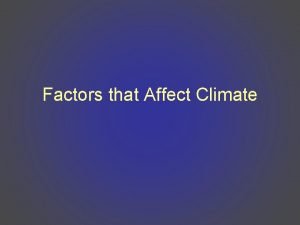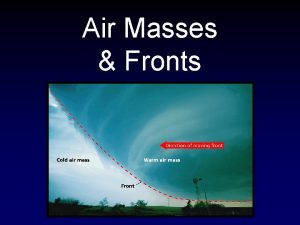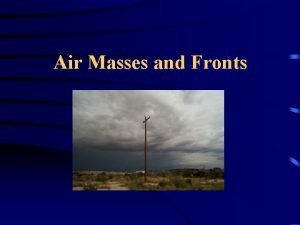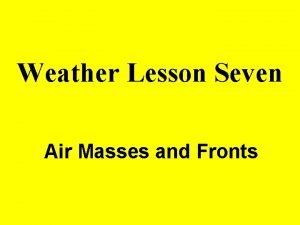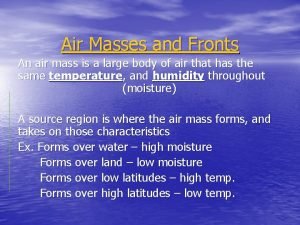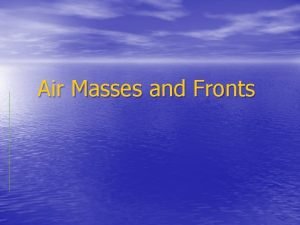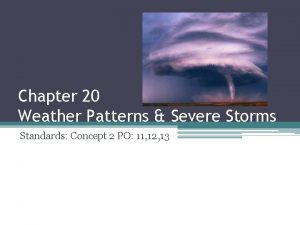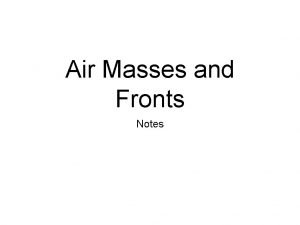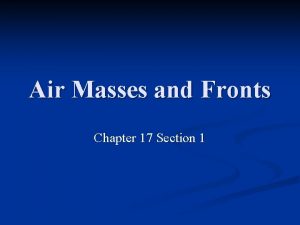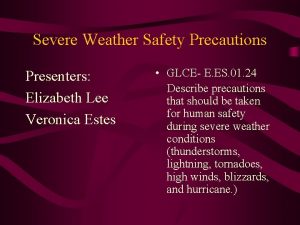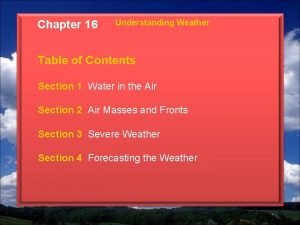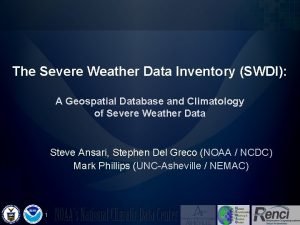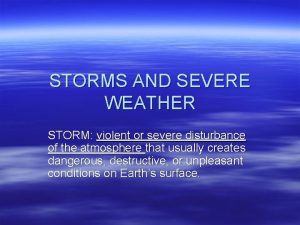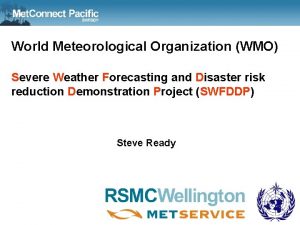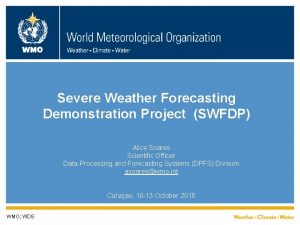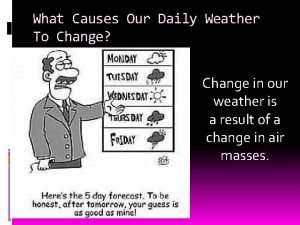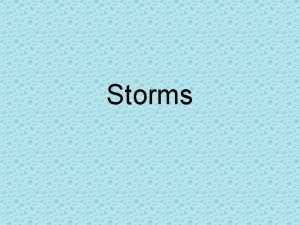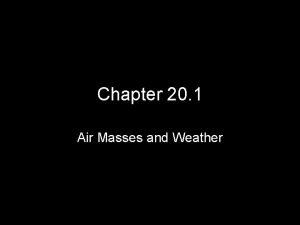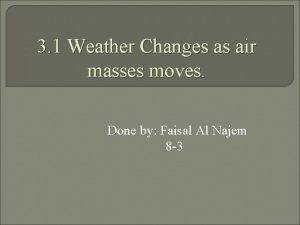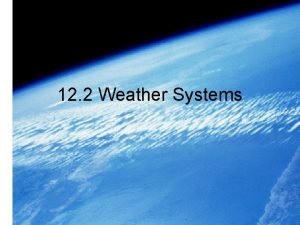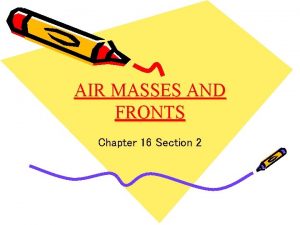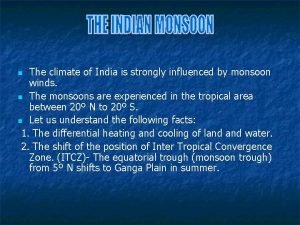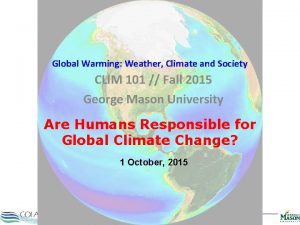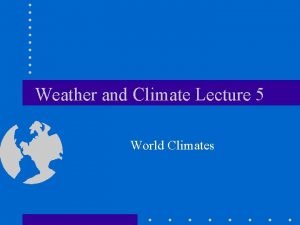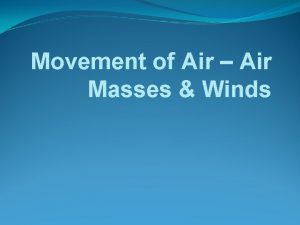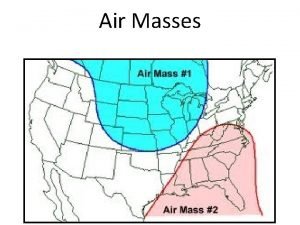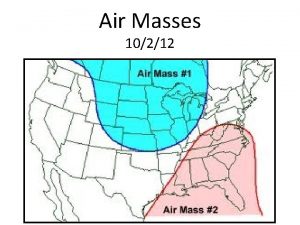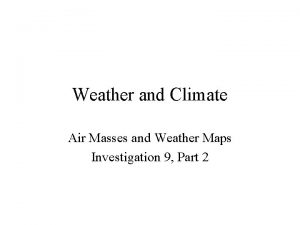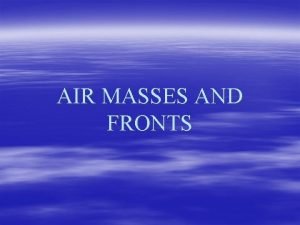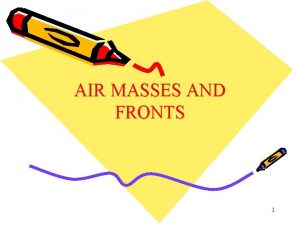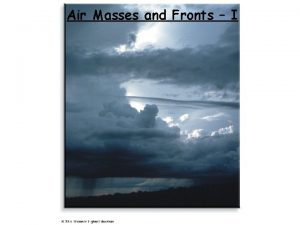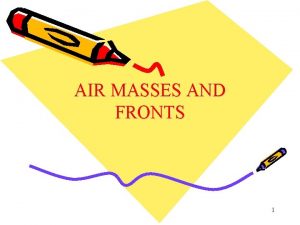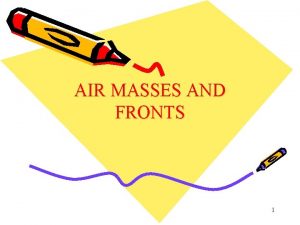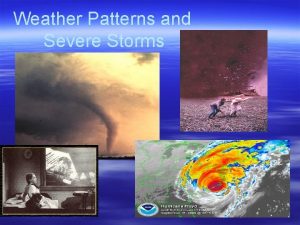Weather and Climate WIND AIR MASSES SEVERE WEATHER



















































- Slides: 51

Weather and Climate WIND AIR MASSES SEVERE WEATHER CLIMATE MOVEMENT 100 100 100 200 200 200 300 300 300 400 400 400 500 500 500

What is the main cause of air movement around the Earth. Answer

Differences in temperature Home

The Coriolis Effect is when winds curve instead of moving in straight lines. What causes this to happen? Answer

The rotation of Earth on its axis. Home

What do cooler temperatures do to the air to cause wind? Answer

Cooler air is more dense and sinks, warm air moves in above the cool air. Home

What commonly causes ocean breezes on the coast? Answer

When the water and land is heated at different speeds Home

Answer

The Sun Home

The main reason air moves around the Earth is… Answer

Differences in temperature between air masses Home

Thunderstorms often happen when cooler air forces underneath warm air. The line where the storms move through is called… Answer

A cold front Home

What will form when a large lowpressure air mass meets a large highpressure air mass? Answer

A front will form Home

What are the properties that describe a cold air mass? Answer

High pressure and high density Home

What do we call the measure of the amount of water vapor in the air? Answer

humidity. Home

A rapidly rotating cloud that forms over land causes destruction over a multi state area. Answer

tornado Home

Which storm is longer lived, larger in size and generates more rainfall: tornadoes or hurricanes? Answer

Hurricanes Home

Why do hurricanes lose energy when they travel on land for a few days? Answer

The air above the land is dry and cooler than the ocean where it forms. Home

Why don’t hurricanes form near the cold dry air of the polar climate zone? Answer

Hurricanes need warm and moist air that is found at the equator. Home

What causes hurricanes to move to the east after moving onto land for several days? Answer

Global winds or Coriolis effect Home

Why do coastal towns have a smaller temperature range from coldest to warmest of the year? Answer

The temperature of the coastal towns is influenced by the slow changing ocean temperatures. Home

The change in temperature and humidity of a small area over a few days is called. . Answer

weather Home

The average temperatures and humidity levels of a large area over time, that is influenced by its closeness to oceans and distance from the equator or poles. Answer

climate Home

What causes the temperatures at the equator to stay nearly the same all year? Answer

The sun’s angle stays directly overhead all year at the equator. Home

An air mass that blows down to the United States from Canada would have which name: a. Maritime tropical b. Continental polar c. Continental tropical Answer

continental Polar c. P Home

Where does the energy come from that causes weather on our planet? Answer

The Sun Home

What type of thermal energy transfer best describes how the surface of the Earth is heated by the Sun? Answer

radiation Home

What causes high tide and low tide in the Earth’s oceans? Answer

The pull of the moon’s gravity Home

What characteristic of Earth is responsible for the seasons? Answer

the tilt of its axis Home

How does the tilt of the Earth’s axis affect differences in daylight and weather at the poles? Answer

Since the Earth’s axis is tilted, the poles are farther away from the sun in winter and the light is spread out over the land, closer to the sun in summer, more daylight. Home
 How does wind affect weather and climate
How does wind affect weather and climate What is this
What is this Two cold air masses converge on a warm air mass
Two cold air masses converge on a warm air mass Whats an air mass
Whats an air mass Air masses & frontswhat is an air mass?
Air masses & frontswhat is an air mass? What are the seven
What are the seven A swirling center of low air pressure is called
A swirling center of low air pressure is called Air masses & frontswhat is an air mass?
Air masses & frontswhat is an air mass? Air masses & frontswhat is an air mass?
Air masses & frontswhat is an air mass? Stationary front
Stationary front Chapter 20 weather patterns and severe storms
Chapter 20 weather patterns and severe storms Chapter 20 weather patterns and severe storms
Chapter 20 weather patterns and severe storms Air masses and their characteristics
Air masses and their characteristics Area of low pressure where air masses meet and rise
Area of low pressure where air masses meet and rise Air masses and fronts
Air masses and fronts How a warm front forms
How a warm front forms Air masses form in the tropics and have low pressure
Air masses form in the tropics and have low pressure North american air masses
North american air masses Where do polar and tropical air masses develop
Where do polar and tropical air masses develop Severe weather safety precautions worksheet
Severe weather safety precautions worksheet Chapter 16 section 3 severe weather answer key
Chapter 16 section 3 severe weather answer key Severe weather data inventory
Severe weather data inventory Severe weather graphic organizer
Severe weather graphic organizer Wmo severe weather
Wmo severe weather Wmo severe weather
Wmo severe weather Bill nye thunderstorms
Bill nye thunderstorms North american air masses
North american air masses Jet stream map
Jet stream map Warm front picture
Warm front picture Large scale rotating air mass
Large scale rotating air mass Importance of air masses
Importance of air masses Characteristics of air masses
Characteristics of air masses Cyclogenesis occurs along the________.
Cyclogenesis occurs along the________. Air masses
Air masses Types of air masses
Types of air masses Tropical air mass
Tropical air mass Tropical air masses
Tropical air masses Modification of air masses
Modification of air masses What are the five types of air masses?
What are the five types of air masses? Continental arctic air mass symbol
Continental arctic air mass symbol Air masses
Air masses Air masses
Air masses Narrow region separating two air masses
Narrow region separating two air masses Answer
Answer Air masses
Air masses Front
Front Air higroskopis air kapiler dan air gravitasi
Air higroskopis air kapiler dan air gravitasi Climate change 2014 mitigation of climate change
Climate change 2014 mitigation of climate change The climate of india is strongly influenced by which winds
The climate of india is strongly influenced by which winds Wind von backbord weicht wind von steuerbord
Wind von backbord weicht wind von steuerbord Clim 101
Clim 101 Cimates
Cimates

